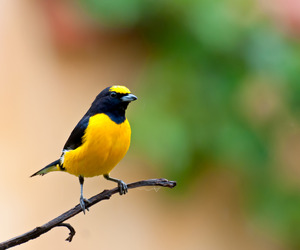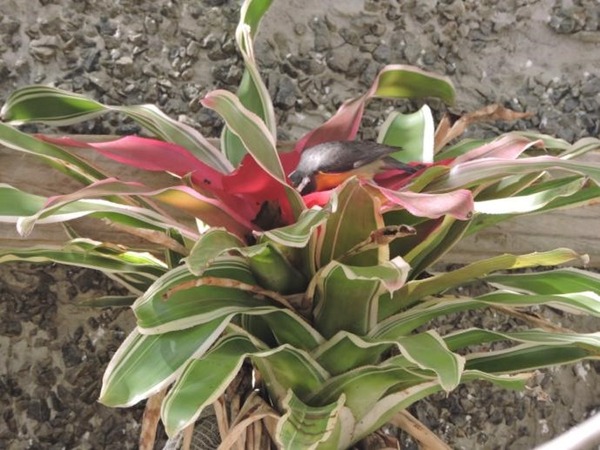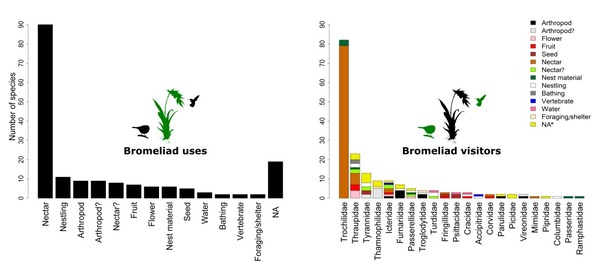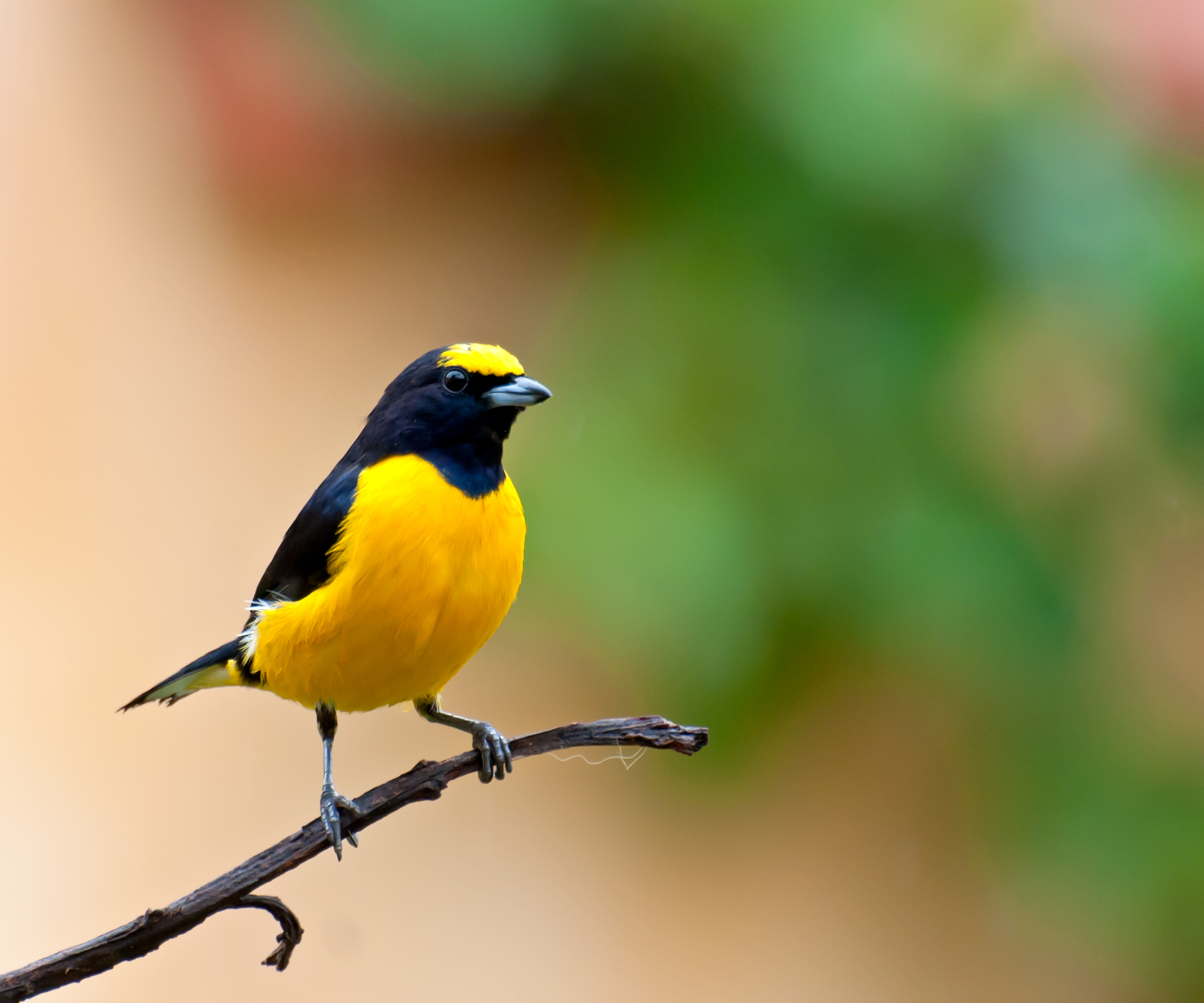 LINKED PAPER
LINKED PAPER
Neotropical bromeliads as food sources for birds: a systematic review and perspectives on the management of ecological interactions. Rocha, J. 2022 Ibis. doi: 10.1111/ibi.13138 VIEW
Since my childhood, I have always been fascinated by the biodiversity of Brazil, which motivated me to pursue a career as a biologist. Especially, I recognize myself as a “bird lover”, justifying why birds always caught my eye in my seminal research in Brazilian ecosystems. During my undergraduate and master’s degrees, I was able to conduct research in the Atlantic Forest of Brazil, which allowed me to discover astonishing biodiversity.
A colleague and I once saw a Purple-throated Euphonia (Euphonia chlorotica) feeding on an epiphytic bromeliad while doing fieldwork for my Master’s degree. Given that the species is primarily frugivorous, we got curious about what kind of food the bird consumed from the plant. I also asked myself: how many bird species use bromeliads as food sources? Surprisingly, I could verify that there is a lack of accurate information on interactions between other birds and epiphytic plants, such as bromeliads. Recording the Euphonia on a bromeliad motivated me to investigate the importance of these special plants for birds.

Figure 1 A Bananaquit (Coereba flaveola) feeding on a bromeliad in an urban area of Brazil © Joedison Rocha.
I noted in my seminal studies that there is a debate about the impoverishment of understory plants in tropical habitats (Barthlott et al. 2001, Reid et al. 2016). However, actions to recover epiphytic plants are poorly considered to improve local habitats for any animal group. Despite this, some studies have pointed out that bromeliads may substantially contribute to the maintenance of high bird diversity in natural and managed habitats in the Neotropics due to the provision of food items, water, and shelter (Cruz-Angón & Greenberg 2005, Cestari 2009). Thus, I thought that this interesting relationship between birds and bromeliads deserved a thorough review.
Based on 88 studies published between 1965 and 2020 across the Neotropical region, I detected 627 unique interactions between birds and bromeliads, involving 162 bird species from 22 families, interacting with at least 190 bromeliad species. Most visits by birds on bromeliads were for feeding. Thus, I was able to verify that bromeliads (epiphytic and terrestrial forms) act as “wildlife restaurants” by providing a varied “menu” for birds throughout the year, including nectar, flower tissues, water, fruits, seeds, and invertebrates (Fig 2).

Figure 2 Resource provided by bromeliads and explored by birds across studies in the Neotropics, highlighting the richness of all recorded bird taxonomic groups (family). NA*: species were documented on bromeliads, but the specific use (e.g. food or nesting) was not recorded, whereas food items marked with a ‘?’ refer to the likely consumed resource as discussed in the studies.
Hummingbirds (Trochilidae) were the main bromeliad visitors across studies, consuming nectar and nest materials (Fig 2). Also, studies reported that nectar-, invertebrate-, and fruit-eaters are the main visitors of bromeliads. Despite that frugivorous birds were the third most common group recorded on bromeliads; frugivory events seem to be rare in these plants. Despite that, the subfamily Bromelioideae shows fleshy fruits potentially attractive to birds compared to the dry fruits of the other Bromeliaceae groups. I raised two hypotheses to explain these findings: a) most of the bromeliad species are more dependent on other seed dispersal agents, such as bats, mammals, and frogs or wind (anemochory) (Benzing 2000); b) frugivores visit bromeliads to exploit other food items, such as water and nectar (e.g. tanagers and curassows), instead of fruits. Based on this, I wonder what that Euphonia I saw in my master’s degree fieldwork was eating or drinking…Perhaps, nectar? Water? Or even a small fruit? Anyway, I encourage more studies addressing interactions between avian frugivores and bromeliads.
Given that bromeliads can provide many food items, nest materials, and shelters for birds and many other vertebrate and invertebrate species, I strongly believe that these plants play an important function in enhancing the quality of local habitats. Thus, strategies to recover bromeliad diversity (as well as other epiphytes) may result in habitats with species-richer communities of birds compared to habitats impoverished of epiphytes, as pointed out in some studies (e.g. Cruz-Angón & Greenberg 2005). In fact, restoring the diversity of bromeliads is quite straightforward, given that thousands of epiphytic bromeliads fall naturally to the forest floor per year with suitable conditions for transplantation in degraded areas (Toledo-Aceves et al. 2014). Adequate management strategies to collect fallen bromeliads and more experimental evidence of this strategy would be beneficial for the conservation of both birds and bromeliads.
References
Barthlott, W., Schmit-Neuerburg, V., Nieder, J. & Engwald, S. 2001. Diversity and abundance of vascular epiphytes: a comparison of secondary vegetation and primary montane rain forest in the Venezuelan Andes. Plant Ecology 152: 145-156. VIEW
Benzing, D.H. 2000. Bromeliaceae: Profile of an Adaptive Radiation. Cambridge: Cambridge University Press. VIEW
Cestari, C. 2009. Epiphyte plants use by birds in Brazil. Oecologia Australis 13: 689-712. VIEW
Cruz-Angón, A. & Greenberg, R. 2005. Are epiphytes important for birds in coffee plantations? An experimental assessment. Journal of Applied Ecology 42: 150-159. VIEW
Reid, J.L., Chaves-Fallas, J.M., Holl, K.D. & Zahawi, R.A. 2016. Tropical forest restoration enriches vascular epiphyte recovery. Applied Vegetation Science 19: 508-517. VIEW
Toledo-Aceves, T., García-Franco, J.G. & López-Barrera, F. 2014. Bromeliad rain: an opportunity for cloud forest management. Forest Ecology and Management 329: 129-136. VIEW
Image credit
Top right: Euphonia chlorotica © Dario Sanches CC BY SA 2.0 Wikimedia Commons.
If you want to write about your research in #theBOUblog, then please see here.




